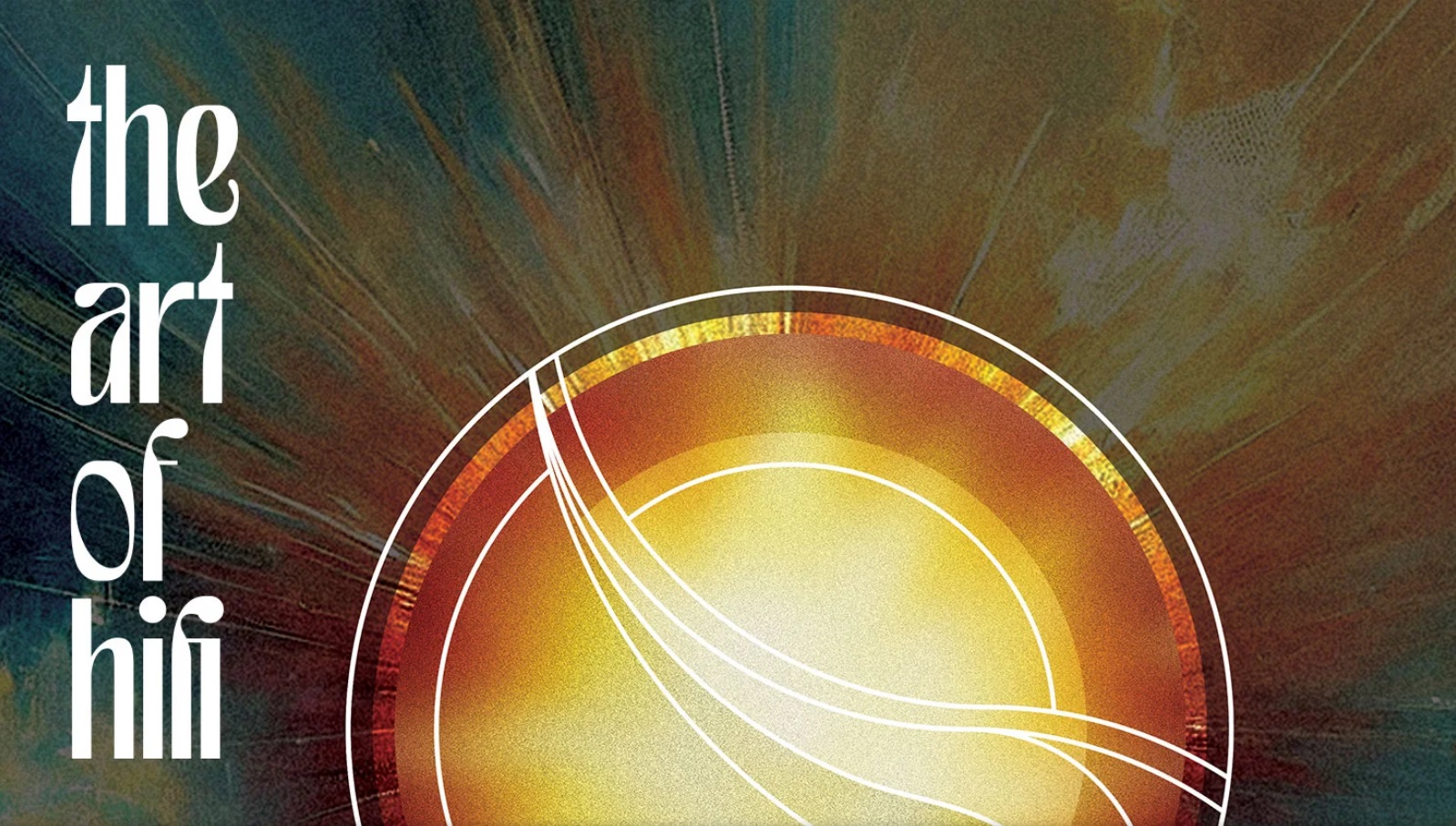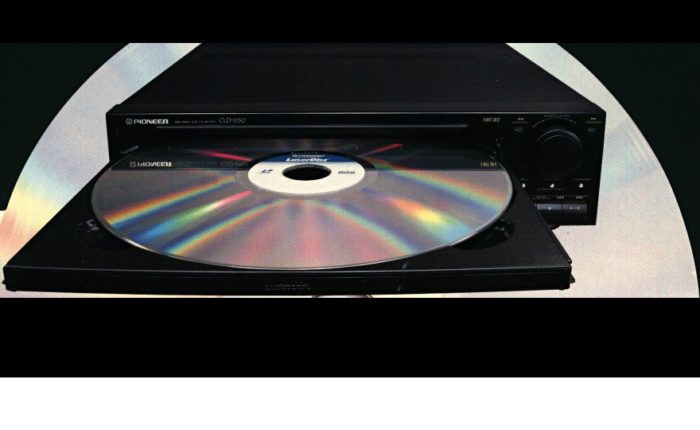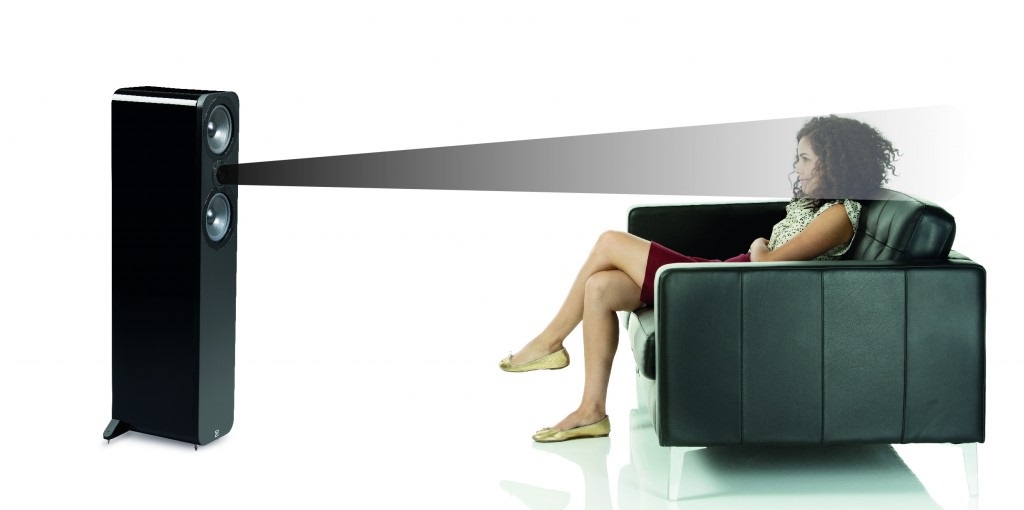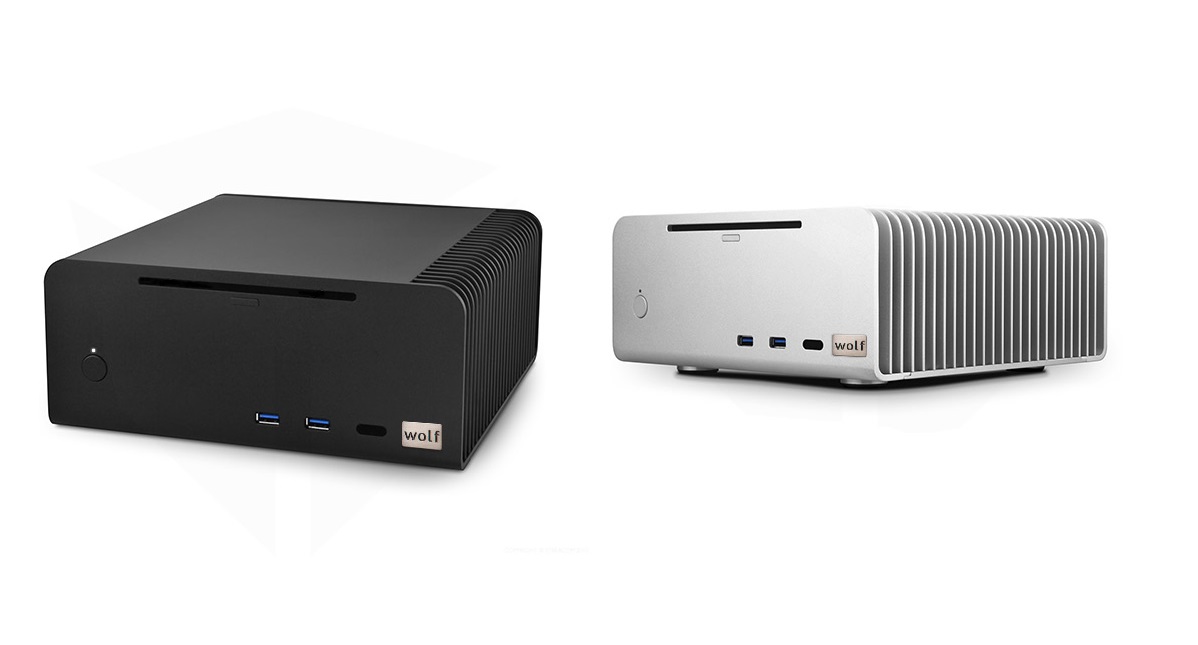The Art of Hi-Fi, Volume 6: Guitars from Octave Records Features an Extravaganza of Playing Styles and Sounds – Octave’s latest offers a wide selection of guitar styles and genres, from solo acoustic to all-out rock on overdrive – September, 2024 – What’s not to love about guitar music? Especially when it’s as well-recorded and soulfully played as the selections on The Art of Hi-Fi Volume 06: Guitars, the latest release from Octave Records. The album features a wide range of artists, styles, and instruments, from the solo acoustic 12-string guitar of Bill Kopper on “Hungry Heart” to Americana, jazz, pop, well-loved covers, and Connor Terrones tearing it up on Jimi Hendrix’s “Manic Depression.” It’s all here, captured in Octave Records’ stunning Pure DSD high-resolution recording quality. Paul McGowan, Octave Records’ CEO pointed out: “Guitars are part of the soundtrack of our lives, from sweet acoustic and warm jazz tones to the powerful electric guitar sounds that have galvanized generations of listeners. Yet it’s extremely challenging to capture these many and varied musical and sonic flavors on a recording. We are thrilled with the sound and performances of our Octave artists on The Art of Hi-Fi Volume 06: Guitars, who did a fantastic job of showcasing the almost limitless potential of the instrument.” The Art of Hi-Fi Volume 06: Guitars was recorded with Octave’s Pyramix-based Pure DSD 256 recording system, using a variety of microphones to capture the wide variety of guitars on the album: steel-string and nylon-string, 12-string guitar, electric, pedal steel, resonator, and even baritone guitar. Everything from the crystalline overtones of a steel-string guitar to the roar of a guitar amp speaker pushed beyond its limit is here to enjoy. The album was recorded, mixed and produced by Paul McGowan, with Terri McGowan and Jessica Carson assisting in the recording and production duties. It was mastered by Gus Skinas. The album begins with Julian Peterson’s soulful Americana-tinged “Am I Wrong” by Keb’ Mo’, singing and playing a resonator guitar using a slide, a deep, elemental sound. The bossa-nova-tinged “Amor Prohibido” features Bill Kopper on nylon-string, accompanied by bass and percussion. It’s a lively musical dialogue, beautifully recorded. Kopper and the trio also contribute “Sweet Lorraine,” played gypsy jazz style with a snappy, cutting guitar tone, and he goes solo with the gorgeous 12-string sound and complex fingerpicked voicings of “Hungry Heart.” The wailing sound of the pedal steel guitar is featured on Greg Schochet’s country original, “Broken Down Chair,” with Schochet’s plaintive singing and sparse acoustic guitar playing carrying a wry tune about likening his life to the well-worn piece of furniture. Khabu Young contributes a dazzling instrumental version of the Beatles’ “Come Together” on solo baritone guitar, and the amount of sound he gets out of just the one instrument is remarkable. The Seth Lewis Trio offers intimate versions of the Bacharach/David classics, “The Look of Love” and “Close to You,” featuring the warm, rich tones of Lewis’ acoustic and electric basses, along with piano, organ, and drums. Wyn Walke digs into the 1930s American classic “Deep Elem Blues,” made popular by the Grateful Dead in the 1960s, performed here in a stately version with vocals, lap steel guitar, bass, percussion, and piano. The Art of Hi-Fi Volume 06: Guitars closes with a dramatic musical shift: Connor Terrones’ incendiary instrumental version of “Manic Depression,” with multiple guitars, bass, and drums blasting away to bring the album to a roaring no-holds-barred conclusion. Turn it up! The Art of Hi-Fi Volume 06: Guitars features Octave’s premium gold disc formulation, and the disc is playable on any SACD, CD, DVD, or Blu-ray player. It also has a high-resolution DSD layer that is accessible by using any SACD player or a PS Audio SACD transport. In addition, the master DSD and PCM files are available for purchase and download, including DSD 512, DSD 256, DSD 128, DSD 64, and DSDDirect Mastered 352.8 kHz/24-bit, 176.2 kHz/24-bit, 88.2 kHz/24-bit, and 44.1 kHz/24-bit PCM. (SRP: $29usd / $39 cad.) |
Tag Archives: Blu-ray
Why Not Laserdiscs In The 2020’s?
In this, our new high tech world, a lot of people may think I’ve gone decidedly crazy.
I’ve always wanted the man cave ‘aka’ cinema room to have a nostalgic feel to it. I started collecting videos at the tender aged of 11. All my friends growing up called me videoboy lol because I was the go-to-guy to get films from on vhs videotape but one format that always intrigued me was laserdisc.
A Little History
LaserDisc (often abbreviated as LD) is a home video format and the first commercial optical disc storage medium, initially licensed, sold and marketed as MCA DiscoVision in North America in 1978. No one can say for sure if the disco craze at that time was responsible for its early name or if it was simply a play on the word ‘disc’. Whatever the reason, the early DiscoVisions have distinct cover designs which make them quite collectible and they have a certain unique retro-funk all of their own.
Although the format was capable of offering higher-quality video and audio than its consumer rivals- VHS and Betamax videotape, LaserDisc never managed to gain widespread use in North America, largely due to high costs for the players and video titles themselves and the inability to record TV programs. It was not a popular format in Europe and Australia when first released but was popular in the 1990s. By contrast, the format was strongly embraced in Japan and in the more affluent regions of Southeast Asia, such as Hong Kong, Singapore and Malaysia, and was the prevalent rental video medium in Hong Kong during the 1990s. Its superior video and audio quality made it a popular choice among videophiles and film enthusiasts during its lifespan. The technologies and concepts behind LaserDisc were the foundation for later optical disc formats including Compact Disc (CD), DVD and Blu-ray (BD).
A Little Boasting
LaserDisc had a number of advantages over VHS (and Beta) videotape. It featured a sharper picture with a horizontal resolution of 425 TVL lines for NTSC and 440 TVL lines for PAL discs, while VHS featured only 240 TVL lines in NTSC (VHS HQ offered 260). It could handle analog and digital audio where VHS was mostly analog only (VHS did have PCM audio in professional applications but was uncommon), and the NTSC discs could store multiple audio tracks. 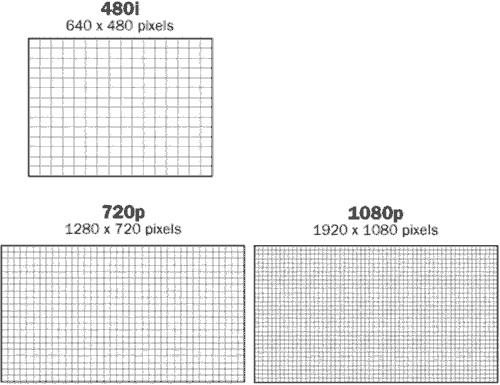 This allowed for extras such as director’s commentary tracks and other features to be added onto a film, creating “Special Edition” releases that would not have been possible with VHS. Disc access was random and chapter based, like the DVD format, meaning that one could jump to any point on a given disc very quickly. By comparison, VHS would require tedious rewinding and fast-forwarding to get to specific points.
This allowed for extras such as director’s commentary tracks and other features to be added onto a film, creating “Special Edition” releases that would not have been possible with VHS. Disc access was random and chapter based, like the DVD format, meaning that one could jump to any point on a given disc very quickly. By comparison, VHS would require tedious rewinding and fast-forwarding to get to specific points.
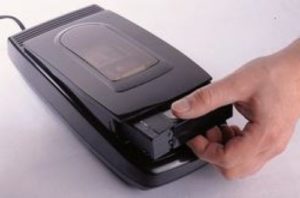
LaserDiscs were initially cheaper than videocassettes to manufacture, because they lacked the moving parts and plastic outer shell that are necessary for VHS tapes to work, and the duplication process was much simpler. A VHS cassette has at least 14 parts including the actual tape while LaserDisc has one part with five or six layers. A disc can be stamped out in a matter of seconds whereas duplicating videotape required a complex bulk tape duplication mechanism and was a time-consuming process. However, by the end of the 1980s, average disc-pressing prices were over $5 USD per two-sided disc, due to the large amount of plastic material and the costly glass-mastering process needed to make the metal stamper mechanisms. Due to the larger volume of demand, videocassettes quickly became much cheaper to duplicate, costing as little as $1 USD by the beginning of the 1990s.
LaserDiscs potentially had a much longer lifespan than videocassettes. Because the discs were read optically instead of magnetically, no physical contact needs to be made between the player and the disc, except for the player’s clamp that holds the disc at its center as it is spun and read. As a result, playback would not wear the information-bearing part of the discs, and properly manufactured LDs would theoretically last beyond one’s lifetime. By contrast, a VHS tape held all of its picture and sound information on the tape in a magnetic coating which is in contact with the spinning heads on the head drum, causing progressive wear with each use (though later in VHS’s lifespan, engineering improvements allowed tapes to be made and played back without contact). Also, the tape was thin and delicate, and it was easy for a player mechanism, especially on a low quality or malfunctioning model, to mishandle the tape and damage it by creasing it, frilling (stretching) its edges, or even breaking it.
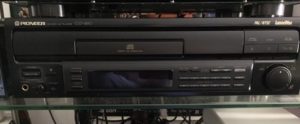
LaserDisc players also had several advantages of VHS and other format playback machines. Some models, such as my Pioneer CLD-1850 are able to playback both NTSC movies and PAL movies. Since I live in the UK- this means that I can buy Laserdiscs from America or Japan (or anywhere in the world that uses NTSC video) and they will play in my machine. Try doing that with VHS or DVD. 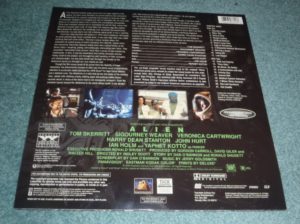 Another important innovation for Laserdisc was the fact that it was the very first home video format to offer Dolby Digital Surround Sound- often referred to as AC-3 on Laserdisc jackets and hardware. Many fans of Laserdisc are still enjoying this feature because some movies such as the Alien AC-3 LD were released with their original cinema surround mix on the AC-3 Laserdisc and those mixes are unavailable on today’s modern formats such as Blu-ray or UHD Blu-ray. Many early LD players can even be modified to turn them into AC-3 LD players.
Another important innovation for Laserdisc was the fact that it was the very first home video format to offer Dolby Digital Surround Sound- often referred to as AC-3 on Laserdisc jackets and hardware. Many fans of Laserdisc are still enjoying this feature because some movies such as the Alien AC-3 LD were released with their original cinema surround mix on the AC-3 Laserdisc and those mixes are unavailable on today’s modern formats such as Blu-ray or UHD Blu-ray. Many early LD players can even be modified to turn them into AC-3 LD players.
The Death And Re-birth Of Laserdisc
By the time of the advent of the DVD, LaserDisc had declined considerably in popularity, so the two formats never directly competed with each other. In fact, combination LD/DVD players were introduced into the marketplace and continue to be quite popular with collectors as these players tend to be flagship models with advanced features such as digital 3D comb filters and digital frame memory and effects. It’s too bad that I couldn’t afford the format at the time , and I really don’t know why I’ve decided to pull the trigger now as Jez would put it lol.

Prices on the used market are still quite high on these combi players but other machines are affordable and the LD’s themselves can usually be found at affordable prices with exceptions for the ultra rare and more obscure releases. I can’t say exactly
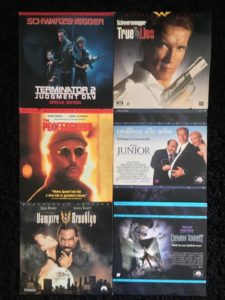
what has me so excited again about Laserdisc and why I’m back in the hunt but I really like the way the discs are packaged in big vinyl like slips, they look so cool. The artwork has totally sucked me in. I’ve started my journey, but I don’t know where it will end. And of course that journey has to begin with Schwarzenegger LD’S. “Get to da choppa! Hurry!” ![]()
For the Silo, Anneal Butt- member of Laserdiscs & Hardware Enthusiasts on Facebook.
Featured image via highdefdigest.com
Audiophile Pure DSD Release Showcases Classical Guitarist Ana Vidovic

| Guitarist Ana Vidović Performs a Spellbinding Selection of Classical Works On Live at Hampden Hall — Renowned classical guitarist Vidović offers a program of J.S. Bach, Barrios, Scarlatti, Sor and more in an intimate Pure DSD 256 live recording– Boulder, Colorado, September, 2023 – Octave Records is honored to present internationally-acclaimed classical guitarist Ana Vidović on its latest release, Ana Vidović Live at Hampden Hall. Recorded with impeccable clarity using Octave’s Pure DSD 256 process, the album features Vidović in an intimate live setting performing a two-disc set of works by J.S. Bach, Barrios, Scarlatti, Sor and other composers. Ana Vidović has been hailed as one of the world’s finest classical guitarists. She began playing at age eight and became the youngest student to attend the Academy of Music in Zagreb, Croatia. She has appeared at recitals, concerts and festivals worldwide and won numerous international awards including the Fernando Sor Competition in Italy, the Francisco Tarrega Competition in Spain, the Eurovision Competition for Young Artists, and many others. She is a graduate of the Peabody Institute. Vidović plays with a beautifully expressive, rich tone, where notes seem to bloom out of her instrument, an Australian Jim Redgate guitar. Vidović said, “Guitar is a very interesting instrument with such a wide range of colors and dynamics. I really try to explore that.” Ana Vidović Live at Hampden Hall presented her with the opportunity to fulfill a lifelong dream. “My wish has always been to do a live recording. And finally, I had a chance to do that, so I’m very happy.” Recorded at Hampden Hall in Englewood, Colorado, all the nuance and expression of her playing were captured using Neumann U67 large-condenser main and close mics, along with a stereo Telefunken mic at a distance for hall ambience. The album was recorded using Octave’s Pure DSD 256 process to convey the highest level of clarity, depth, spaciousness and musical realism. The double album, available on disc or in two volumes via download, was recorded, mixed and produced by Paul McGowan, with assistance from Jessica Carson and Terri McGowan. It was mastered by Gus Skinas. Ana Vidović Live at Hampden Hall features Octave’s premium gold disc formulation, and the discs are playable on any SACD, CD, DVD, or Blu-ray player. They also have a high-resolution DSD layer that is accessible by using any SACD player or a PS Audio SACD transport. In addition, the master DSD and PCM files are available for purchase and download, including DSD 256, DSD 128, DSD 64, and DSDDirect Mastered 352.8 kHz/24-bit, 176.2 kHz/24-bit, 88.2 kHz/24-bit, and 44.1 kHz/24-bit PCM. (SRP: two disc-set, $58usd / 78$cad ; each volume via download, $19 – $39usd / 26$- $53cad depending on format.) The album begins with a masterwork – a guitar transcription of J.S. Bach’s Cello Suite No. 1 in G Major. Vidović performs this extremely challenging piece with a spellbinding depth of feeling. Other selections include Bach’s Violin Sonata No. 1, the Gran Sonata Eroica, Op. 150 and Grande Ouverture Op. 61 by Mauro Giuliani, Intro and Variations on a Theme by Mozart, Op. 9 by Fernando Sor, and Augustin Barrios’ magnificent La Catedral, all performed with Vidović’s remarkable virtuosity and connection with the music. She noted, “My goal is to present each piece in a unique way, to try to find things that always have the guitar in mind and what the instrument can do.” For the Silo, Frank Doris. |
Definitive Guide to Speaker Setup Now Available
Octave Records Debuts The Audiophile’s Guide: The Loudspeaker, the Definitive Guide to Speaker Setup
– New book and companion SACD disc/download dive into exacting, step-by-step detail on how to get the most out of any loudspeaker –
Boulder, Colorado, October, 2022 – PS Audio’s Octave Records label announces its latest release, The Audiophile’s Guide: The Loudspeaker, a book and companion SACD/download that tells listeners exactly how to get the most out of their loudspeaker setup. Written by PS Audio CEO Paul McGowan, the book and its accompanying disc (also available as a download) offer the practical knowledge he’s gained through more than 50 years of high-end audio design and in setting up hundreds of speaker systems.

“I’ve had to come to the rescue of someone’s system time and again because it just wasn’t sounding right. It was almost always a setup problem. Like everyone else, I used favorite music tracks for system tuning. But now, with Octave Records’ recording studio at our disposal, we were able to create tracks that are ideal for system setup, and then write a book that tells listeners how to implement these tracks to their best advantage.”
The Audiophile’s Guide: The Loudspeaker is useful for both novices and experienced audiophiles who may benefit from bringing their setup to a higher level or musical realism.
The book begins by covering a variety of topics including the nature of sound, different speaker designs, the importance of choosing the right speaker for your particular needs and listening tastes, and one of the most critical aspects of speaker setup: the effect of the listening room on loudspeaker performance.
Next the book discusses where to place the speakers in the room, and how to deal with various types and shapes of rooms. The Guide notes that different placements may be appropriate for different speaker types – for example, stand-mounted “box” speakers versus dipole planar designs – and listening room configurations (such as whether to place speakers across the short or long wall of a room). Real-world aspects like accommodating living spaces that aren’t dedicated to loudspeakers, and taking into account the locations of furniture, are also considered.
The Audiophile’s Guide: The Loudspeaker (SRP: $58usd/ $79 cad – $68usd/ $93cad depending on format) then walks the listener through using the accompanying reference disc (or download) to fine-tune the system to perfection. The disc starts with some basic tests for channel orientation and moves on to exacting, step-by-step procedures (time to get out the tape measure!) for getting the best bass response and tonal balance, achieving a solid center image, finding the best seating position, maximizing dynamics, producing a believable soundstage, capturing subtle musical details, and ultimately, getting the speakers to “disappear” and create the feeling that the musicians are in the room with the listener.
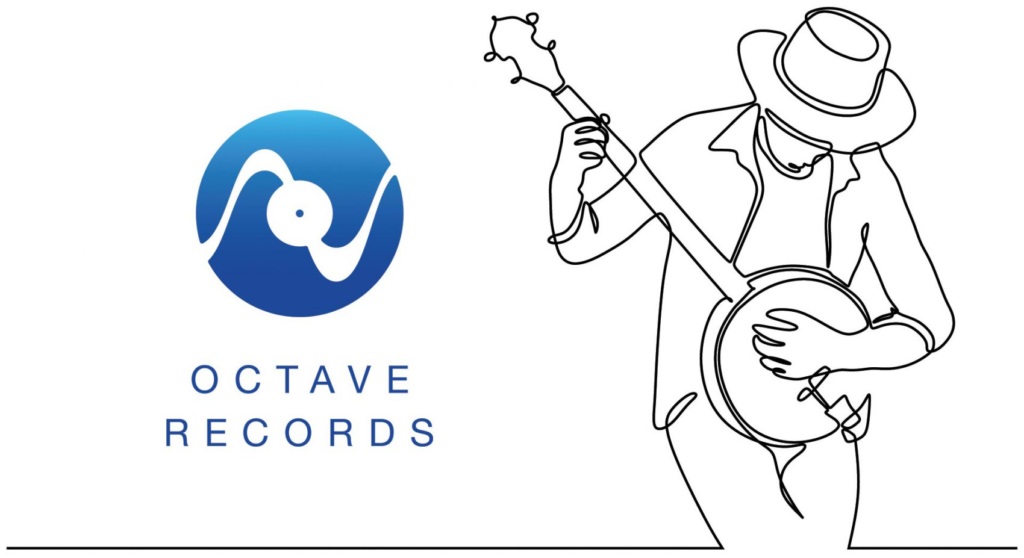
The tracks on the disc are tailored to help the listener zero in on various sonic aspects, from the pluck of Chris Brunhaver’s acoustic bass and how it energizes the room, to the focused center image of Gabriel Mervine’s trumpet, and the resonance and spatiality of Bill Kopper’s acoustic guitars and a number of tracks featuring vocalists with a full band.
The Recording
Recorded over three months of intense work, The Audiophile’s Guide: The Loudspeaker was the first recording project at Octave Records’ new state-of-the-art studios. Recorded in pure DSD256 and mixed by Paul McGowan and Jay Elliott, the tracks on this work were laid down with every effort to maintain not only the purity of recording, but the accuracy of mic’ing, distance, and purpose. The mic’ing on solo voice, piano, trumpet, and guitar was primarily handled with a single-point stereo microphone to maintain a sense of realism. In particular, Octave Records’ hand-modified AKG C24 was used throughout the many tracks. On other tracks, like guitarist Bill Kopper’s seminal work focusing on the beauty of ringing harmonic overtones, we blended the detailed stereo condensers of the single-point Telefunken with the dynamic impacts of a single-point stereo ribbon microphone. Engineers Jay Elliott and Zach Balch went all out to get the best recordings from an amazing drum kit.

The kit (the same kit used in The Audiophile’s Guide: The Stereo) consists of a Ludwig 1970 Blue Sparkle 20” kick drum, 12” rack tom, 16×16” floor tom, 14 x 6.5” Ludwig Superphonic John Bonham LM 402 snare drum, Zildjian New Beats Hi-hat 70’s era 14”, Custom Dark Crash Kerope by Zildjian Crash 18”, and a Kerope by Zildjian 22” ride. To capture this kit, Jay and Zach employed their favorite setup for close mic’ing: a Shure Beta 52 for the kick-in and a cardioid patterned, phantom powered, large-diaphragm FET Soundelux U195 by David Bock for the kick-out. The top of the snare was handled by a Hypercardioid Beyerdynamic M201 with its phase flipped while the snare’s bottom was a Telefunken M80. The rack tom was captured by a Shure SM7B Cardioid dynamic microphone and the floor tom, an Audix D4 hypercardioid dynamic microphone.

To capture the ambient room response, a pair of calibrated DPA omnis were used for the overheads, and the stereo AKG C24 in a Blumlein configuration was placed twelve feet into the room for space recording. All microphone preamplifiers were Manly vacuum tubes with a small smattering on the overheads using Forsell preamps. The tracks were all mixed in Octave Records’ custom mixroom on PS Audio’s aspen FR30 loudspeakers powered by an all-PS Audio system.


The Audiophile’s Guide: The Loudspeaker SACD is playable on any SACD, CD, DVD, or Blu-ray player (an SACD player is required to play the high-resolution DSD files on the disc). In addition, the master DSD and PCM files are available for purchase and download in formats up to 352.8 kHz/DSD256 from psaudio.com at this link.
Highest End Media Streamer Offers Optional Flux Capacitor Upgrade
Wolf Audio Systems Announces Its Luna R High Fidelity Audio Servers

JACKSONVILLE, FL, — Wolf Audio Systems, a company dedicated to providing the ultimate in digital music source components today announced the introduction of its Luna R Audio Server, created to deliver the finest-available high-resolution and streaming audio playback. Leveraging technology and infrastructure developed for the award-winning Alpha 3 SX class of audio servers, Wolf has refined the second generation of the Luna to achieve audio quality levels previously found only in Wolf’s full-sized server lines.
Upgrade
The Wolf Luna R is, first and foremost, engineered to deliver extraordinary audio performance. Utilizing the same silicon architecture found in the Alpha 3 SX, Wolf’s second-generation Luna brings the Luna line much closer to Alpha and Red Wolf-level sound quality. The redesigned Flux Capacitor master clock is an optional upgrade; by operating at a high 24MHz clock rate, the Flux Capacitor ensures more accurate reconstruction and transmission of digital audio.
Depending on the option chosen, the Luna R features either an audio-modified Windows 10 Pro or new, proprietary Linux-based WolfOS operating system. The Luna R offers 2TB storage capacity (expandable to 32TB), 24-bit and DSD playback capability, an upgraded Flux Capacitor 24 MHz master clock and additional improvements. The Flux Capacitor creates one of the most perfect USB Audio signals with less jitter and better accuracy, for a more natural and more involving musical presentation, whether in stereo or multichannel PCM and DSD.
Versatile and Compact
The Luna R has a sleek, half-rack design that fits easily into any audio system. It can play back a wide variety of stereo and multichannel audio formats including FLAC, WAV, AIFF, ALAC, SACD, DSF, DFF, (PCM) from 16 – 32 bits, 44.1, 88.2, 96, 176.4, 192, 384, and 768 kHz audio, and DSD DoP and Native up to DSD1024.
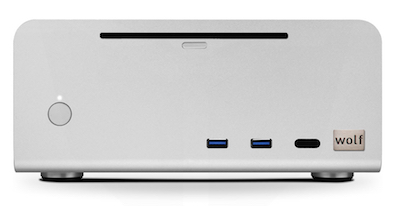
At the heart of the Luna R is Wolf’s Windows-based operating system. Users can also opt to utilize WolfOS Linux-based operating system, based on Ubuntu software. The WolfOS features a custom kernel that offers the lowest I/O latency possible, keeps the audio functions isolated from the rest of the server and works seamlessly with the Luna R’s output circuitry. The Luna R includes 2TB of SSD (solid state drive) storage capacity for ultra-fast access to all content. An optional 32TB of expansion capability can also be added internally, while the Luna R can interface with external hard drives and any NAS system via the network. The Luna R’s Teac Blu-ray transport, now standard on Wolf audio servers, enables users to rip CDs and play audio discs in DVD and Blu-ray. The drive can also burn discs for storage or transport.
The SX Upgrade
The Luna R incorporates a host of additional refinements to ensure ultimate audio performance. These upgrades are the result of a collaboration between Wolf Audio Systems, Stillpoints and eXemplar Audio. The refinements address the areas of micro-vibration control, electrical grounding and radio frequency interference (RFI) suppression. For example, the server incorporates Portals, a new patent-pending type of grounding-noise conditioning, to remove MHz- and GHz-frequency power contamination and deliver a new level of clarity and resolution. Stillpoints internal standoffs are used to attenuate internal micro-vibrations, while constrained layer damping materials reduces ambient vibration to the case and non-critical componentry. Audience OHNO high-purity oxygen-free copper internal wiring ensures maximum signal purity.
The Luna R offers easy access to its musical content via HDMI and DisplayPort for use with a television and/or monitor. Its wireless connectivity also allows the user to control all functions using a wireless keyboard, mouse or tablet, or via a home automation system remote control, and also remote access via web browser and iOS/Android applications.
Like all Wolf Audio servers, the Luna R is compatible with a wide range of audio applications and streaming audio formats including Roon, JRiver, Audirvana, Qobuz, Tidal, Deezer and others. The server can connect to a TV or monitor to display album cover art, artist, track and album information and more. It offers a full complement of USB, Ethernet, HDMI and IR inputs and outputs, ensuring compatibility and full function for years to come.
The Luna R is currently available in black or silver finish at a retail price of $4,500 usd with 2TB of storage, and $5,000 usd for the Luna R Pure Digital Edition, with the Flux Capacitor included and 4TB of storage. The unit can be supplied with optional Stillpoints Mini SS isolation feet at an additional $500 usd.
